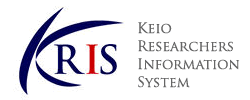-
Affiliation
-
Graduate School of Media and Governance (Shonan Fujisawa)
-
Position
-
Project Senior Assistant Professor (Non-tenured)/Project Assistant Professor (Non-tenured)/Project Lecturer (Non-tenured)
-
Related Websites

KEIO RESEARCHERS INFORMATION SYSTEM |
Details of a Researcher
このページはJavascriptを使用しています。すべての機能を使用するためにはJavascript を有効にする必要があります。
Yoshikawa, Harunori
|
|
|
Tokyo University of Agriculture and Technology, Graduate School of Agriculture, 博士研究員
Tokyo University of Agriculture and Technology, 農学系ゲノム科学領域における実践的先端研究人材育成プログラム
University of Dundee, Centre for Gene Regulation & Expression, Postdoctoral Reseach Assistant
The University of Tokushima, Institute of Advanced Medical Sciences, 助教
Keio University, Institute for Advanced Biosciences, Project Lecturer/ PI
Nanotechnology/Materials / Chemical biology
Life Science / Molecular biology
Life Science / Functional biochemistry
RNA
SEC HPLC
proteomics
ribosome
ribosome biogenesis
Linear ubiquitination triggers Amph-mediated T-tubule biogenesis
Kohei Kawaguchi, Yutaro Hama, Harunori Yoshikawa, Kohei Nishino, Kazuki Morimoto, Tsuyoshi Nakamura, Michiko Koizumi, Yuriko Sakamaki, Kota Abe, Soichiro Kakuta, Koichiro Ichimura, Fumiyo Ikeda, Hidetaka Kosako, Naonobu Fujita
2025.04
Cover Feature: Sulfoxide‐Mediated Cys‐Trp‐Selective Bioconjugation that Enables Protein Labeling and Peptide Heterodimerization (ChemistryEurope 3‐4/2024)
Daishiro Kobayashi, Masaya Denda, Junya Hayashi, Kota Hidaka, Yutaka Kohmura, Takaaki Tsunematsu, Kohei Nishino, Harunori Yoshikawa, Kento Ohkawachi, Kiyomi Nigorikawa, Tetsuro Yoshimaru, Naozumi Ishimaru, Wataru Nomura, Toyomasa Katagiri, Hidetaka Kosako, Akira Otaka
ChemistryEurope 2024.05
Proteomic and functional comparison between human induced and embryonic stem cells
Alejandro J. Brenes, Eva Griesser, Linda V. Sinclair, Lindsay Davidson, Alan R. Prescott, Francois Singh, Elizabeth K.J. Hogg, Carmen Espejo-Serrano, Hao Jiang, Harunori Yoshikawa, Melpomeni Platani, Jason Swedlow, Greg M. Findlay, Doreen A. Cantrell, Angus I. Lamond
eLife (eLife Sciences Publications, Ltd) 2024.02
がん特殊化リボソームの同定と機能解析(Identification and characterization of cancer-specialized ribosomes)
常松 貴明, 吉川 治孝, 永尾 瑠佳, 松澤 鎮史, 大塚 邦紘, 牛尾 綾, 石丸 直澄
日本病理学会会誌 ((一社)日本病理学会) 113 ( 1 ) 295 - 295 2024.02
ISSN 0300-9181
An allele-selective inter-chromosomal protein bridge supports monogenic antigen expression in the African trypanosome
Joana R. C. Faria, Michele Tinti, Catarina A. Marques, Martin Zoltner, Harunori Yoshikawa, Mark C. Field, David Horn
Nature Communications 2023.12
co-fractionation MS 新たな網羅的タンパク質複合体解析法
吉川治孝
実験医学別冊 決定版 質量分析活用スタンダード 293 - 299 2023.09
Lead author, Last author
Ribo Mega-SEC:サイズ排除クロマトグラフィーによる簡便なリボソームの分離法
吉川 治孝, Angus I. Lamond
日本プロテオーム学会誌 5 ( 1 ) 13 - 22 2020.05
Lead author, Corresponding author
Proteomic Technologies Reveal Regulatory Mechanism Underlining Ribosome Biogenesis in Human Cells
Takahashi Nobuhiro, Yoshikawa Harunori, Izumikawa Keiichi, Ishikawa Hideaki
Proteome Letters (Japanese Proteomics Society) 2 ( 1 ) 7 - 15 2017
リボソームの機能調節と疾患 II.リボソームRNAの転写後修飾とアセンブリー II‐1 リボソームサブユニット生合成の調節
吉川治孝, 泉川桂一, 石川英明, 高橋信弘
生化学 (日本生化学会) 85 ( 10 ) 861 - 870 2013.10
ISSN 0037-1017
Involvement of p32, fibrillarin, and Nop52 in pre-90S particle separation during human ribosome biogenesis
H. Yoshikawa, W. Komatsu, T. Hayano, Y. Miura, K. Homma, K. Izumikawa, H. Ishikawa, N. Miyazawa, H. Tachikawa, Y. Yamauchi, T. Isobe, N. Takahashi
MOLECULAR BIOLOGY OF THE CELL (AMER SOC CELL BIOLOGY) 22 2011
ISSN 1059-1524
定量プロテオミクスによる核⼩体リボソーム⽣合成過程の解明
吉川 治孝
日本プロテオーム学会2023年大会JPrOS2023 (21st JHUPO),
Symposium, workshop panel (nominated)
Co-Fractionation MS(CF-MS)による細胞内巨大タンパク質複合体の解析
吉川 治孝
第23回日本蛋白質科学会年会,
Symposium, workshop panel (nominated)
Co-Fractionation MSによる細胞内巨大タンパク質複合体の解析
吉川 治孝
第71回質量分析総合討論会,
Symposium, workshop panel (nominated)
細胞内タンパク質合成装置リボソームの効率的な解析法 Ribo Mega-SECの確立とその応用
吉川 治孝
徳島大学大学院医歯薬学研究部 2022年度骨・筋とCaクラスター・ミニリトリート,
Public lecture, seminar, tutorial, course, or other speech
核小体ヒトプレリボソームの新規分離法が切り拓くリボソーム合成因子の網羅的解析
吉川 治孝
第45回 日本分子生物学会年会,
Symposium, workshop panel (public)
日本学術振興会, Grants-in-Aid for Scientific Research, Grant-in-Aid for Scientific Research (B), No Setting
相互作用タンパク質の同定・トポロジー解析を指向した光活性型クロスリンカーの開発
日本学術振興会, Grants-in-Aid for Scientific Research, Grant-in-Aid for Scientific Research (C), No Setting
定量プロテオミクスが紐解く新規タンパク質複合体によるHPV陽性癌の新たな病因論
日本学術振興会, Grants-in-Aid for Scientific Research, Grant-in-Aid for Scientific Research (B), No Setting
Support for the creation of the post-lysosomal biology research area.
日本学術振興会, Grants-in-Aid for Scientific Research, Nakamura Shuhei, Grant-in-Aid for Transformative Research Areas (B), No Setting
Comprehensive analysis of post-lysosome mediators in body fluid
日本学術振興会, Grants-in-Aid for Scientific Research, Fujita Naonobu, Grant-in-Aid for Transformative Research Areas (B), No Setting
Poster award
2019.07, JPrOS 2019 (17th JHUPO) and JES 2019 Joint Annual Meeting, Towards the comprehensive characterisation of cellular protein complexes by Size Exclusion Chromatography
Poster Prize: Proteomics in Cell Biology and Disease Mechanisms, EMBL–WELLCOME GENOME CAMPUS CONFERENCE (Heidelberg, Germany)
Harunori Yoshikawa, 2019.03
Marie Skłodowska-Curie Individual Fellowships MSCA-IF-2014-EF
Harunori Yoshikawa, 2015.02, European Commission
Postdoctoral Fellowship
Harunori Yoshikawa, 2014.12, Uehara Memorial Foundation
Postdoctoral Fellowship of Research Abroad
Harunori Yoshikawa, 2014.02, Naito Foundation
PROTEOMICS
2025
PROTEOME ANALYSIS LABORATORY PRACTICE
2025